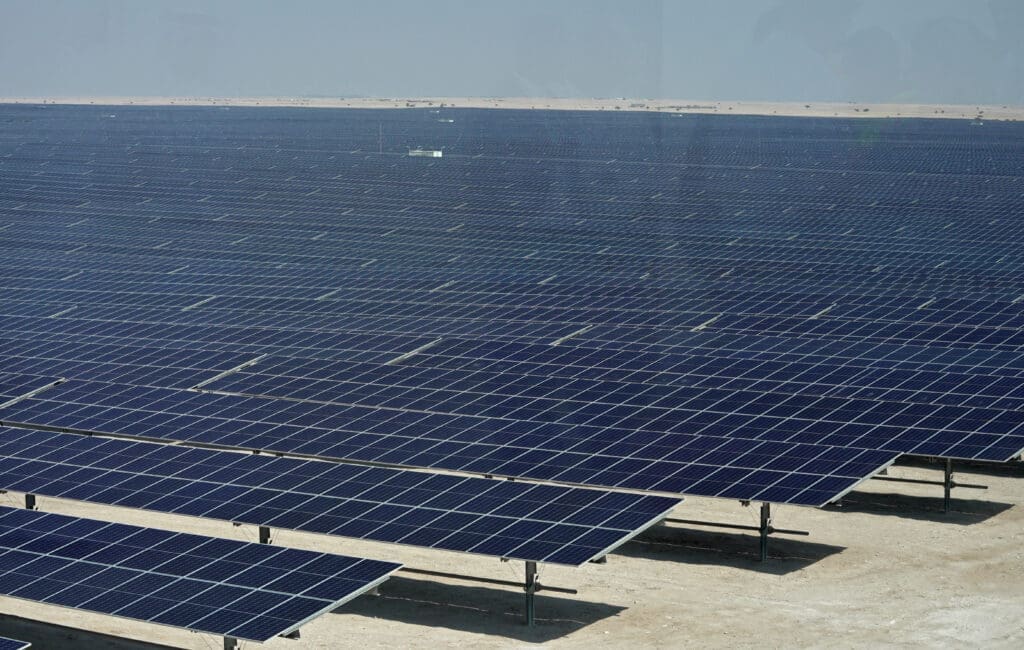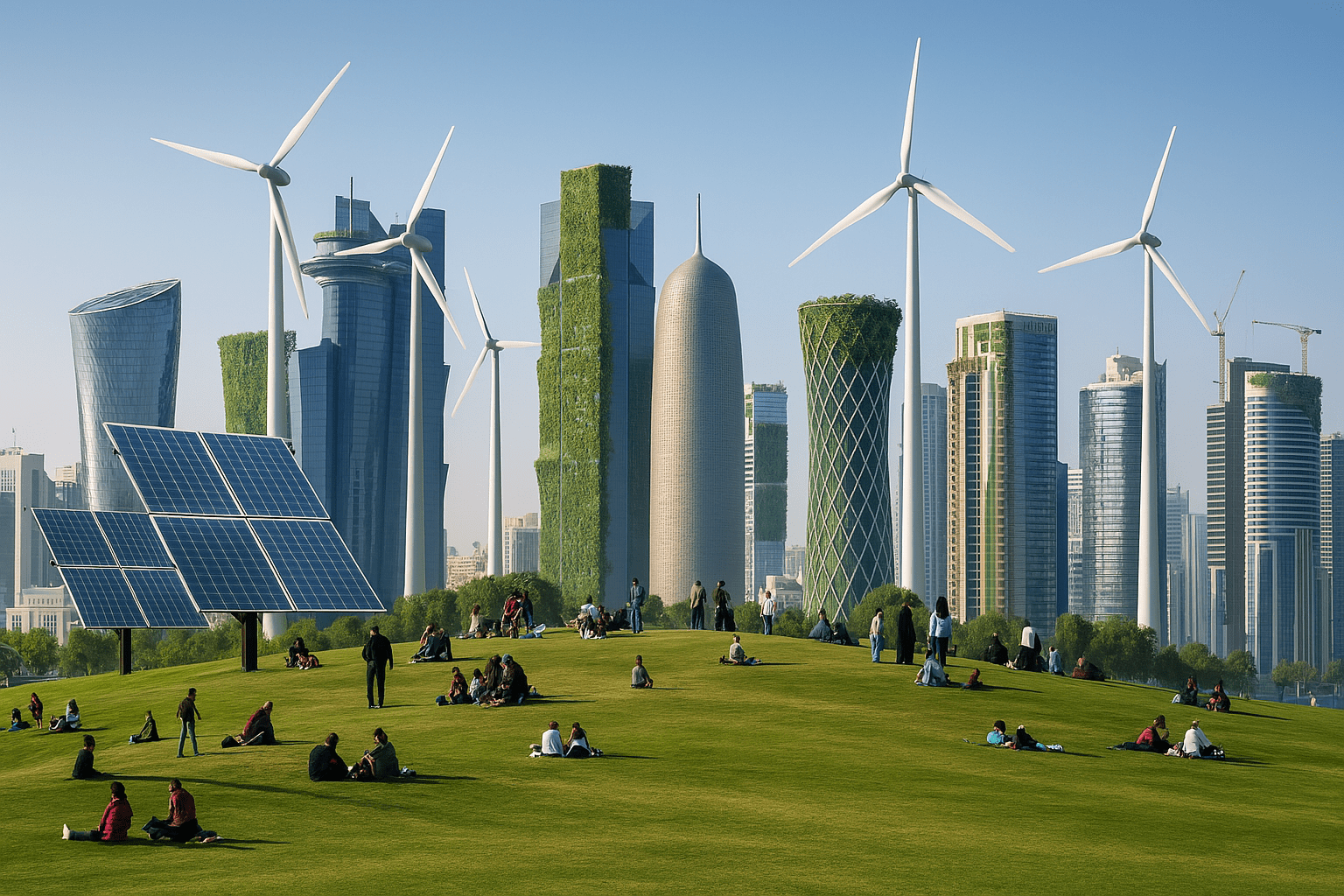
Qatar, Energy Exports and the Low Carbon Technology Debate
February 2025
Introduction
The debate around energy production and low carbon technologies is of vital importance to Qatar, for two reasons. Firstly, on the domestic front, low carbon technologies can contribute to wider national strategies for tackling the challenges Qatar faces in terms of energy security, economic diversification and climate change. Secondly, Qatar’s role as a key player in the global energy market and as a leading exporter of liquefied natural gas (LNG) means it will be impacted by the rise of low carbon technologies. This chapter analyzes the role of low carbon technologies in Qatar’s domestic and foreign policies.
An Energy-Led Economy and Climate Change
Qatar’s contemporary state-building, nation-branding, and independence have all been symbiotically tied to energy production and the export revenues accrued to state coffers through sales of fossil fuels. Furthermore, Qatar has historically depended almost entirely on carbon-heavy oil and natural gas for its domestic energy needs. With the rapid development of infrastructure in this urbanizing, climate-challenged city-state, Qatar’s decision-makers have had to prioritize meeting the demands of domestic energy consumption. Qatar ratified the United Nations Framework Convention on Climate Change (UNFCCC) in 1996 and signed the Kyoto Protocol in 2005. In 2008, the government launched Qatar National Vision 2030, which outlined a series of ambitions for the country’s future, covering economic diversification, environmental protection, and sustainable development. The document also outlined technological advances in the area of energy production, as well as proactive policies for mitigating climate change.
In 2012, Qatar hosted the UN’s 18th climate change conference (COP18), gathering over 20,000 delegates to discuss climate action. In 2016, Doha signed and subsequently ratified the Paris Agreement, the results of which can be seen on multiple levels. In 2019, the Emir of Qatar pledged $100 million to support small and developing nations in tackling climate change. The subsequent National Climate Change Plan, approved in 2021, set out a strategic framework for Qatar’s sustainability goals, aiming to reduce the country’s carbon footprint by 25% while balancing its role as a significant LNG producer.1
Qatar aims to meet its global climate commitments, prepare for future low carbon energy importers, and secure reliable, long-term contracts for its natural gas exports. Natural gas is viewed by many as a transitional fuel that can bridge the gap between traditional fossil fuels and renewable energy sources. It is less carbon-intensive than other fossil fuels, making it an important component of Qatar’s strategic goals of maintaining energy export reliability while reducing emissions. The regularization of the annual National Climate Change Dialogue (organized in partnership with international actors including Germany), as well as wider state-led initiatives and innovation on low carbon technologies have proved important for bolstering Qatar’s domestic energy resilience.
The increasing focus on decarbonization and emerging technologies has prompted Qatar to adopt cleaner energy sources, implement mitigation measures, and diversify its energy portfolio. Qatar’s transition involves expanding its traditional and clean energy offerings while gradually adopting renewables and launching energy efficiency initiatives, as well as investing in research and new technologies that will enable the transition away from hydrocarbons.
To meet local energy demand, Qatar is not only investing in new energy sources but also in energy and water efficiency, and the electrification of local transport. Energy efficiency is being promoted through the Tarsheed program,2 an energy efficiency initiative aimed at reducing consumption across all sectors, including residential, commercial, and industrial. At the same time, electric vehicles (EVs) are part of the strategy to reduce local carbon emissions.3 The country has announced an ambitious plan to increase the adoption of electric vehicles, supported by a network of charging stations to cut emissions from the transport sector.
At the same time, Qatar’s North Field—the world’s largest natural gas field—is undergoing a significant expansion to dramatically increase production capacity. This ambitious development will not only strengthen Qatar’s export capabilities but also restore its position as the world’s leading producer of LNG, a status held by the United States in recent years. The expansion project is part of Qatar’s long-term strategy to secure energy market dominance and meet growing global demand for cleaner energy. To achieve this, state hydrocarbons firm QatarEnergy has formed partnerships with several international energy majors, including ExxonMobil (U.S.), Total Energies (France), Shell (United Kingdom / Netherlands), ConocoPhillips (U.S.), Eni (Italy), Chevron (U.S.), China National Petroleum Corporation (China), China Petroleum & Chemical Corporation or Sinopec (China), and Korea Gas Corporation or KOGAS (South Korea).4 These partnerships reflect the global nature of the energy industry itself and Qatar’s central role as a supplier.
The LNG expansion could also help further enhance regional energy security. Gulf, including GCC energy and climate dialogues are increasingly focused on the part that LNG can play in energy security, resilience, integration and meeting the challenge of climate change. It has already been demonstrated that Qatar’s abundant natural gas reserves and proactive GCC energy strategies make a difference. This is already seen with deals with Kuwait, the UAE and Oman in the Dolphin project.5
Qatar’s Approach to New Technologies
While LNG is at the heart of Qatar’s energy strategy, emerging technologies such as Small Modular Nuclear Reactors (SMRs), e-fuels, hydrogen, and electrification could disrupt Qatar’s LNG market by offering cleaner, competitive alternatives. SMRs, which are gaining traction in energy-intensive countries in Asia and Europe, provide flexible, low carbon power generation.6
Qatar’s energy partners and allies, such as Japan, South Korea, and France, which already use nuclear energy, are exploring SMRs as a strategic alternative, potentially reducing LNG imports for power generation. E-fuels—synthetic fuels derived from hydrogen and carbon dioxide—offer carbon-neutral solutions for sectors such as aviation and shipping, appealing to industries that have traditionally relied on LNG.7
Hydrogen, especially “green” or “pink” hydrogen, is a versatile, zero-emission fuel that could gradually replace LNG in power generation and industrial processes as infrastructure and costs of production improve. This could be coupled with a move to renewables such as wind, hydropower, geothermal and solar power (green hydrogen) as well as nuclear power (pink hydrogen). Other emerging technologies such as carbon pyrolysis offer a way to produce hydrogen from natural gas without CO₂ emissions, potentially transforming LNG into a low-carbon resource.8
To reduce industrial emissions, Qatar relies on carbon capture, utilization, and storage (CCS) to cut emissions from natural gas production. The country is now also leveraging its expertise in natural gas production to become a leader in the hydrogen market through investments in blue ammonia, which is an efficient medium for transporting hydrogen, can be used as a clean fuel, and aligns with global efforts to build a hydrogen economy.9
Qatar has also made substantial domestic investments in renewable energy projects, with a particular focus on solar power. QatarEnergy has announced the construction of several solar power plants, including the Al Kharsaah solar power plant, with a capacity of 800 megawatts (MW), as well as the industrial cities solar power project, with a combined capacity of 875 MW, and the Dukhan solar power plant with a capacity of 2 gigawatts (GW). These investments reflect Qatar’s commitment to renewable energy and to reaching a total renewable energy capacity of 4 GW by the end of the decade10.
Despite this, Qatar remains one of the highest per capita emitters of greenhouse gases in the world, due to emissions from its hydrocarbon industry and its reliance on electricity for cooling and desalination. Industrial processes, including cement, steel, and petrochemical production, also contribute significantly to emissions, both due to fuel combustion and chemical reactions during the production process. The transport sector, including both public and private vehicles, add to emissions, though its impact has been smaller compared to energy and industry. Emissions from residential and commercial sectors are mainly linked to high electricity consumption, especially for air conditioning.11
Qatar has introduced a series of mitigation and transition strategies to address this challenge. For example, the Qatar Research, Development, and Innovation (QRDI) Council has prioritized developing long-term low carbon technologies, efforts that are essential to overcoming technical challenges and ensuring Qatar’s position in the global energy transition. Also, while the main mandate of Qatar Investment Authority (QIA) is to diversify Qatar’s economy and reduce dependence on hydrocarbons both at home and abroad, its portfolio is also demonstrating the country’s investment and strategic interest in low carbon technologies. This includes investing in renewables abroad, such as large-scale renewable energy partnerships in Africa and MENA. QIA is also investing in foreign companies working on battery technologies that are crucial for energy storage.
The Geopolitics of Energy and Low-Carbon Technologies
Today, many energy-producing nations are struggling with the challenges posed by global approaches that prioritize energy security and low carbon technology. Qatar, however, appears to have been proactive in understanding the important strategic and global dimensions of such policies. For example, it demonstrated global leadership in 2023 when it hosted the UN Conference on the Least Developed Countries (LDC5) and has spotlighted issues of climate change and the need for financing and development of low carbon technologies. The LDC5 conference itself adopted the earlier Doha Programme of Action (DPoA)12 that had also addressed the growing challenge of energy security and how to harness low carbon technologies. Qatar pledged $60 million to implement the DPoA and help build resilience in the LDCs.
Qatar accrues certain power attributes from the geostrategic realities that delimit its role as a small state yet as a significant producer and exporter of LNG. The primary international dimensions of such power attributes can be seen in the relative autonomy and independence of its foreign policy agenda, decision-making, and resourcing. Over the past decade, this has allowed Qatar’s leaders to weather a regional blockade, host one of the biggest and most prestigious sporting events in the world—the 2022 FIFA Men’s World Cup—and adhere to its constitutional commitments to employ foreign policy not just for national interests, but also to uphold the rules-based international order and play a vital role as peacemaker.
This last point is now evident in Qatar’s unrivalled global record of mediation not just in the Middle East, but other regions including Europe and South America.13 Additionally, the recognition of Qatar’s neutrality, balance, and dependability has even encouraged great powers such as the U.S. and Russia to rely on Qatar’s mediation for the negotiation of some of the thorniest disputes.
Policy Outlook
Throughout the past decade, Qatar’s decision-makers have oriented its national and foreign policy towards proactive decision-making on energy (including low carbon technologies). A strong nexus has developed between national strategies that address the economy, diversification, and financing for research and innovation—as well as the energy sector, climate and environment policy. Qatar is demonstrating that it can, as former Minister of State for International Cooperation Lolwah Rashid Al Khater asserts, “reconcile multiple priorities, from economic growth to environmental management to human and social development… especially against a backdrop of increasing local and global demand for energy.”14
However, policymakers in this small state, which faces the increasing challenges of desertification, rising temperatures and sea levels, and other climate change and environmental stressors, understand that they cannot go it alone. Low-carbon technologies have played their part in Qatar’s success, and this role may well increase. There is some concern that the adoption of renewable energy has been slower than expected, which does not chime well with Qatar’s broader national development and branding ambitions.
Globally, buyers of Qatar’s energy are at different stages of their energy transitions. Europe has accelerated its transition to renewable energy, focusing on wind, solar, and hydro power as part of its climate goals. The 2022 energy crisis highlighted Europe’s dependence on imported gas, particularly from Russia, pushing for diversification efforts, increased LNG imports outside of Europe, and renewables projects.15 Russia, meanwhile, has shifted its oil and gas exports towards Asian markets such as China and India, where fossil fuels remain dominant—notably China’s appetite for coal. LNG is increasingly popular in these countries, as well as Japan and South Korea. All four are diversifying their supplies and investing in renewable energy and alternatives.16 China leads the world in terms of renewable energy capacity.17 Japan, on the other hand, is re-examining the potential of nuclear power, a decade after the Fukushima disaster.18
Conclusion
Economic, technological, and political factors will all play a role in determining the pace of Qatar’s energy transition. The high cost of scaling up technologies like hydrogen production and carbon capture creates another bottleneck. These technologies require significant investments in research and infrastructure, and Qatar must continue to innovate to overcome these barriers. At the same time, it needs to stay ahead by investing in emerging technologies and fostering international partnerships.
Nevertheless, domestic initiatives have already had a positive impact by steering new approaches to low carbon technology across Qatar’s entire industrial and production sector. In investment terms, this is seen as further enhancing Qatar’s national reputation for reliability, stability and innovation in a region that is far from stable. For example, it is implementing a policy that focuses on revenue, profitability and price stability, not just for itself, but the rest of the world as it transitions.
Qatar has also demonstrated its willingness not only to direct resources towards this endeavor, but also to build the capacity to propel a dynamic and diverse approach to its national energy sector, even as it supports and invests in low carbon alternatives for countries that are more heavily impacted by climate change (such as small island developing states). Taken together, these policies mean the future looks a little bit greener for this small desert country and other climate-affected countries.



